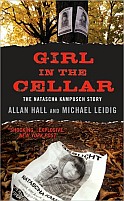|
|
BOOK
ILLUMINATIONS
From Merrimon Book Reviews
|
|
The Girl in the Cellar:
The Natascha Kampusch Story

by Allan Hall and Michael Leidig

Informative without sensationalism
In March 1998, ten year
old Natasha Kampusch was kidnapped on her way to school.
Investigations as to the identity of the abductor or Natasha's
whereabouts come to a dead end. Then more than eight years later,
Natasha, now a young woman, escapes to tell the world a story that will
horrify the world. Natasha has spent this time as a prisoner in
Wolfgang Priklopil's cellar in a suburban home that on the surface
looks ordinary. No one looking from the outside would ever have
suspected that this ordinary man in this ordinary looking life
hald the key to an unimaginable nightmare. Does Natasha's
difficult childhood hide a clue to her future fate? What kind of
monster would commit such an evil act? What kind of person was
Natasha to be able to survive? How was she abducted and why did
the trails and investigation lead nowhere? How did she
escape? How did this young woman, a woman imprisoned and living
her childhood mostly alone, handle the instant media fame frenzy after
her escape?
In THE GIRL IN THE CELLAR,
journalists Allan Hall and Michael Leidig summarize the main facts
behind this horrific true crime without sensationalizing the case,
especially given the fact that Natascha Kampusch herself refuses to
reveal personal details about her life and her relationship with
Wolfgang Priklopil a nd Austria's strict privacy make such
information less available. Without being a detailed
psychological treatise that most lay persons might find tedious, the
authors turn to those in the field to give readers some insight into
the main psychological issues raised by this case. Allan Hall and
Michael Leidig also turn to history and literature to draw a picture
for readers of the few existant cases of similiar but not identical
situations that might help a reader imagine the dynamics of Natascha's
captivity and her relationship with Woflgang Priklopil.
As such, this book is helpful in separating fact from media
hype. Readers of true crime familiar with some of the modern
classics
of literature will appreciate the author's literary examples to spark
the imagination. As with the parallels drawn to concentration
camp
prisoners, or their examination of the psychology, the authors do not
turn this true crime story into a scholarly examination, but rather use
such examples to fill in the reader's imagination and/or provide
readers with other areas to explore without turning away from the case
and issues in hand.
Sixteen pages of color plates and diagrams
accompany the text, allowing readers, particularly American readers
perhaps less conversant in the case, to identify the key characters and
events, then and now. An index at the back helps readers relocate
particular references after finishing the book. Most intriguing
are the author's insight into the media frenzy surrounding her escape,
Natascha's marketing and branding of herself, and the effects this case
has had within Austrian society. Since enough time has elapsed
between the hardcover edition and the release of the mass market
paperback that some details have changed, this reader would have
appreciated an afterward in this mass market edition to update readers
on Natascha Kampusch's life and the possible official closing of the
case.
Written in a journalistic style that summarizes vast amounts of
material into a logical, informative narrative, THE GIRL IN THE CELLAR presents the
facts of the case while also identifying as unknown those details on
which outsiders can only speculate. As such, this book is helpful
in separating fact from media hype. THE GIRL IN THE CELLAR is a
refreshing change from true crime stories this reader has previously
read thanks to the Allan Hall and Michael Leidog's ability to tell the
story without tabloid-like hype and also without romanticizing the
culprit into a literary hero. The case becomes all the more
shocking and horrifying in the author's ability to describe the
ordinariness of the perpetrator. The authors do an excellent job
showing the courage and strength of Natascha Kampusch without
idealizing her. The more troubling aspects of her media created
image are not omitted.
Publisher: Harper
True Crime
(March 9, 2010)
Reviewed by Merrimon,
Merrimon Book Reviews

|
|
|